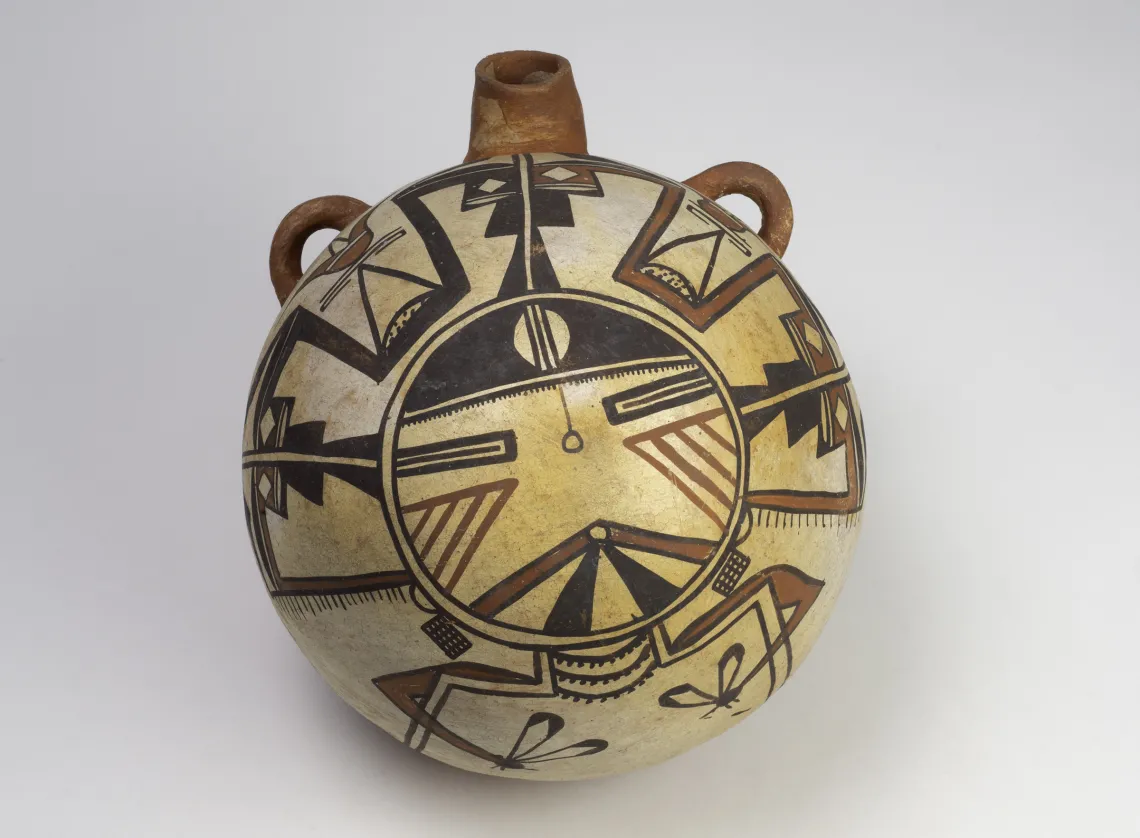
Polacca Polychrome canteen with Palhikwmana (Water-drinking Maiden) Katsina design, c. 1900. Miller Collection, Arizona Archaeological and Historical Society purchase, 1917. Diameter 29.5 cm. (ASM #4099).
This canteen is arguably the most historically significant work by Nampeyo at ASM. Museum records indicate that Nampeyo made this canteen and gave it to Dr. Joshua Miller (see Ferg 2014:43) in exchange for eye treatments. Miller, a medical doctor, came to Arizona in 1883 and spent many summers at Hopi volunteering his services. He treated Nampeyo for trachoma, the eye condition that eventually led to her near blindness. This canteen is the only example of Polacca Polychrome pottery with a reliable Nampeyo attribution that biographer Barbara Kramer was able to locate in 1996; since then, other examples with varying degrees of reliability have been identified. Attributions in some cases have relied upon this canteen as a basis for comparison.
Will the Real Nampeyo Pots Please Come Forward? Challenges of Attribution
This Gallery of Nampeyo Pottery includes both pottery that is firmly identified as having been made by Nampeyo and other pieces that have been attributed to her. Nampeyo never signed her work, so the task of convincingly identifying her works can be daunting. The Nampeyo name appears on several ASM pots but written by other people and not as a signature. How this came to be is discussed below and referenced in the captions for the respective gallery photographs.
With her fame as a potter came an incentive for some collectors and dealers to identify Hopi pottery as Nampeyo’s, even if they had no supporting evidence. This tendency has only amplified through the years since her passing in 1942, as the monetary value of Nampeyo’s pottery has increased dramatically.
The extant photographs of Nampeyo appearing with a varying array of pottery bowls and jars can assist with attributions. This is especially the case when a given pot is clearly visible. Unfortunately, no ASM Nampeyo pottery appears in any of the known historic Nampeyo photographs. It should be noted, however, that Nampeyo may not have formed and painted every pot that is shown with her. Some of the many photographers who took pictures of her may have choreographed the scenes according to compositional rather than documentary considerations. That some of these photos have depicted Nampeyo painting an already fired pot is among the more-obvious clues of staging.
Careful comparisons with well-documented examples of Nampeyo’s pottery, which were made alone or in collaboration, assessment of existing provenance information, and reliance upon curators, other scholars, and the ever-expanding literature on Nampeyo, have guided the process of identifying the works presented.
____________
Note: Several vessels included in this showcase have depictions of katsinas variously identified as Palhikwmana (Water-drinking Maiden) or Sa’lakmana (Shalako Maiden). One First Mesa potter, White Swann, has identified the personages as Palhikwmana, so this is the identification we are using (personal communication, December 8, 2023). We understand that other potters of today may not agree, and we obviously cannot question potters from the past.
Perhaps made by Nampae. Beautiful Specimen," reads the catalog card for this bowl that was part of a large Native American collection that ASM purchased from Nelle A. Dermont of Williams, Arizona, in 1919 (Higgins 2013). The early phase of Nampeyo’s artistic life is not well documented; "perhaps" may be as close as we will get to a Nampeyo attribution. Noteworthy here are the tick marks on the interior, just below the rim. The inclusion of what appears to be a similarly decorated Polacca Polychrome bowl on a low wall in the 1908 photo by Carl Moon below could be either an example of early pottery by Nampeyo or set dressing on the part of the photographer with a bowl made by another potter.
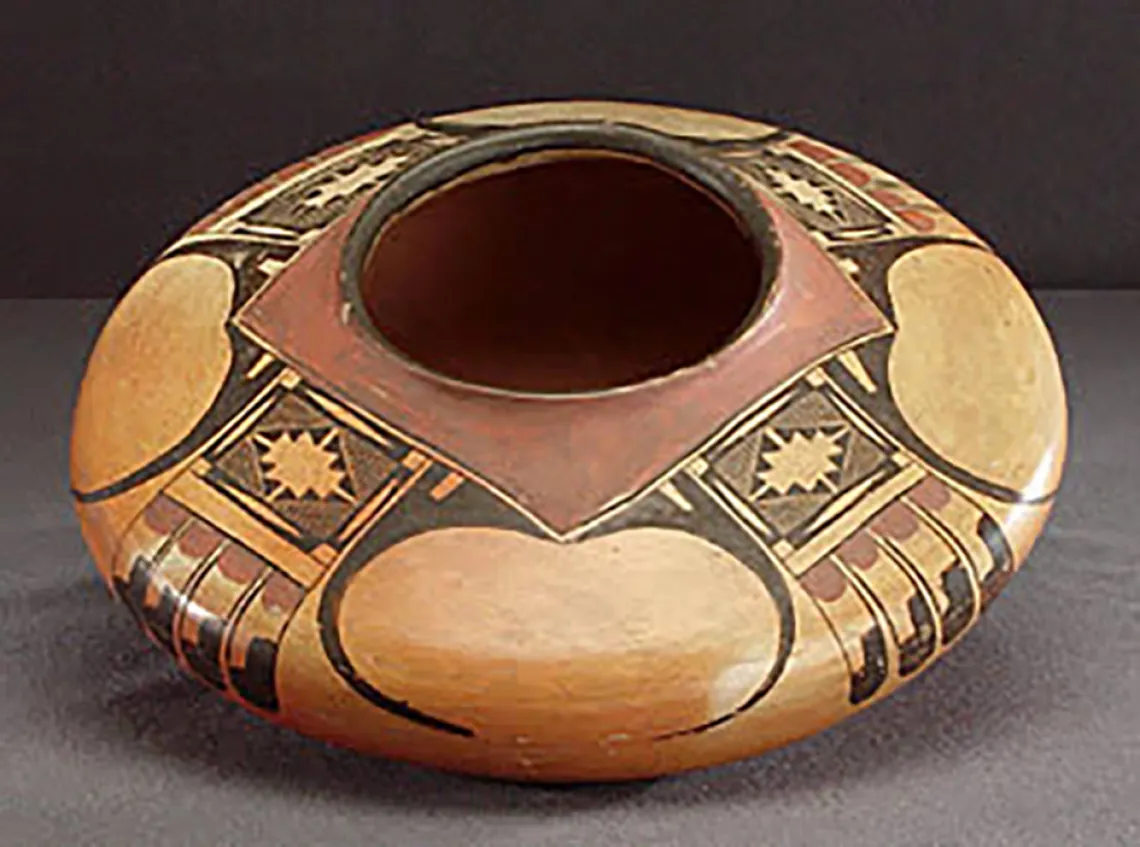
Polychrome jar with “eagle-tail” designs, c. 1900–1905. Gift of the Estate of Julia Howell Overshiner, 1970. Diameter 28.10 cm. (ASM #E-8996).
This signature low, wide-shouldered jar with finely detailed eagle-tail designs, convincingly attributed to Nampeyo, is part of the large Matthew Howell Collection that his daughter Julia Howell Overshiner bequeathed to ASM. Around the early 1900s, Howell was a traveling harness and saddlery salesman who supplied Native crafts for resale to Arizona Saddlery in Phoenix. At the time of the gift, Tucson Indian arts dealer Tom Bahti identified the jar as the work of Nampeyo, based on the “style and technique.” With roots extending back to ancient wares, this is one of Nampeyo's most readily identifiable designs. The eagle tail has been used by and reinterpreted by countless Nampeyo descendants through the years.
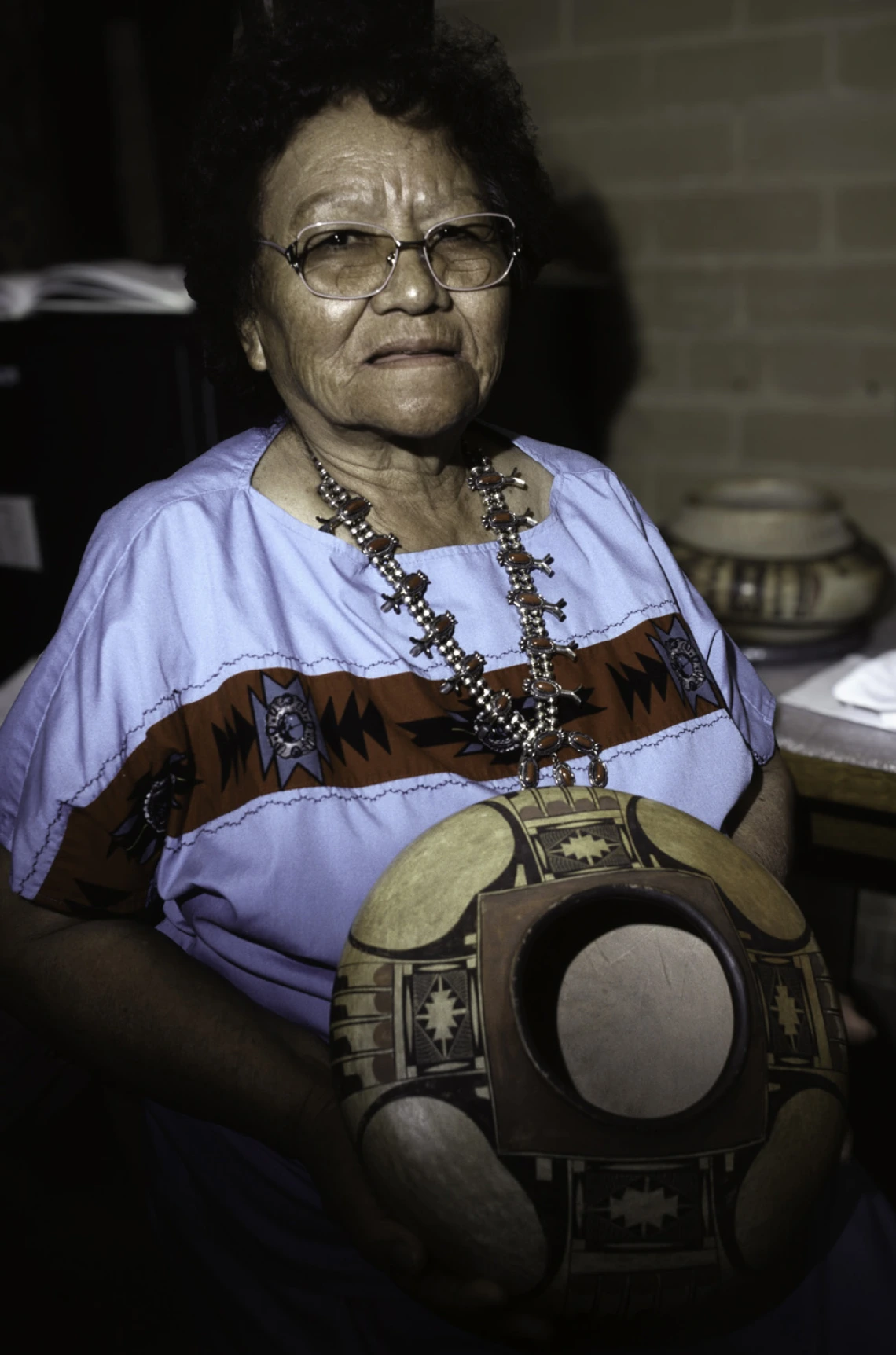
Dextra Quotskuyva (September 6, 1928 – February 2019), great-granddauther of Nampeyo, holds an “eagle-tail” jar (ASM #E-8996) at Arizona State Museum in 1998. Ken Matesich, photographer (ASM C-41795).
Whatever they were using, you know, to represent but I know they use eagle feathers, you know, for designing. And it’s actually what they see from during their times, from ancient designs that have been left behind are mostly just what the designs are in there. Unless you really look at a pot and maybe turn it around and figure out what it is, you'll never know what it means unless you're really used to looking at pots and with the designs that they put on there are most of what they see at that time, just the environment outside....They're getting inspiration from the natural world.
Dextra Quotskuyva, 1998
Great-granddaughter of Nampeyo
Nampeyo Pottery from the Gila Pueblo Collection
In 1951, ASM received a collection of almost 50,000 archaeological and 1,000 ethnographic items from the Gila Pueblo Archaeological Foundation in Globe, Arizona. Gila Pueblo Director Harold Gladwin had created the foundation in 1928 and assembled the collection, but by the late 1940s he decided to close down the foundation and then donated its holdings to ASM. (For background on the Gila Pueblo Archaeological Foundation, see Haury [1988].)
Pottery made by or attributable to Nampeyo was included in the gift. Some pieces came with dates and the places where Gladwin purchased them. Other pots arrived without documentation. Of 28 examples of Hopi and Hopi-Tewa pottery that Gladwin purchased in 1928 from the Commercial Hotel in Holbrook, Arizona, at least five appear to be by Nampeyo. It is unclear if there was a shop in the hotel or if the pottery was in use at the time Gladwin made his purchases. Sadly, the hotel burned down in the 1980s. (Personal communication, Sherry Reed, Interim Director, Navajo County Historical Society in Holbrook, October 6, 2023).
This olla came to ASM as part of the Gila Pueblo Foundation collection. According to records, Nampeyo made this jar, and Gila Pueblo Director Harold Gladwin purchased it in 1926 from Edward Ledwidge, a trader based in El Paso, Texas. Because relatively little Polacca Polychrome pottery by Nampeyo has been positively identified, and few photos of Nampeyo exist from the time period, it is difficult to assess the likelihood that she made this jar. It is also noteworthy that few photos of Nampeyo making such ollas, or of her painting katsina designs, have been found. If such images exist, they have not been widely publicized.
Harold Gladwin purchased this jar, the largest Nampeyo vessel in ASM’s collections, in 1928 along with GP-6216 and GP-6217 (see next pages) from the Commercial Hotel in Holbrook, Arizona. Nampeyo is listed as the maker on the catalog card. Extensive use wear, including drips and paper adhering to the interior walls, indicates its probable use as a trash receptacle, perhaps at the hotel.
The jar likely predates 1928 by five to ten years. A similar jar in a private collection located by Nampeyo scholar Barbara Kramer was attributed to Daisy Hooee (granddaughter of Nampeyo and daughter of Annie Healing). Daisy was born in Arizona in 1906, and, thanks to her patron Anita Baldwin, was educated in Paris in the 1920s (see Kramer 1996:205 for a fascinating account of Daisy’s early life), so she is unlikely to have contributed to the manufacture of this jar. It almost certainly represents a collaborative effort with Nampeyo and another relative. One noteworthy feature is a break in the line that encircles the neck. While such breaks are common in Pueblo pottery, they are found inconsistently on pots identified as Nampeyo’s or attributed to her. Such line breaks have been considered a reference to the fertility of the potter, but their meaning is likely more complicated than that (Stephen in Patterson 1994:132; Hays-Gilpin 2013:196).
Gila Pueblo Director Harold Gladwin purchased this large, wide-shouldered jar from the Commercial Hotel in Holbrook, Arizona, in September 1928. It is very similar to ASM jar GP-6217 (see next photo). Neither is identified as the work of Nampeyo, but it is highly likely that they are both by her. Nampeyo was well known for making jars of this shape, especially in the period around 1920. The painting could have been done by one of her daughters, as Nampeyo’s eyesight was greatly diminished by that time. The jar has remnants of an paper label and the price of $50.00 penciled on the base. This was a substantial sum for Native pottery at this time, an indication of the high regard in which quality Hopi pottery was held. That Gladwin did not ascertain or, in any event, record the maker’s name is surprising, given that he was amassing a comparative collection for his archaeological research facility.
Commenting on the extensive fire clouds on this jar, Dextra Quotskuyva noted:
And this is something I try to stress to my daughter and the rest that I taught. Try to put those fire marks on it. You know, if you don't have those fire marks on it, they say that the fire has to have some hand on it on the pottery.
And that's the only way you can show that the fire had gone in and touched every area of the pottery. You see, everything that we do is connected to the earth. So that's the reason why it's so different for someone else to understand what you're saying, you know? Yeah. Like, because there's so much to it, you know, that we consider even in our pottery the way we fire.
Harold Gladwin purchased this large jar, one of a pair with GP-6216 (see previous), from the Commercial Hotel in Holbrook, Arizona, in September 1928. Neither is identified as the work of Nampeyo, but it is highly likely that they both are. Nampeyo was well known for making this form of jar, especially during this period. Whether she was also the painter is another question. This jar has a pattern that repeats five times around the perimeter, an accomplishment in asymmetry at which Nampeyo was known to be particularly adept. If she did not do the painting, another family/clan member also appears to have had such skill.
Click on either side of the photo to advance the slide show.
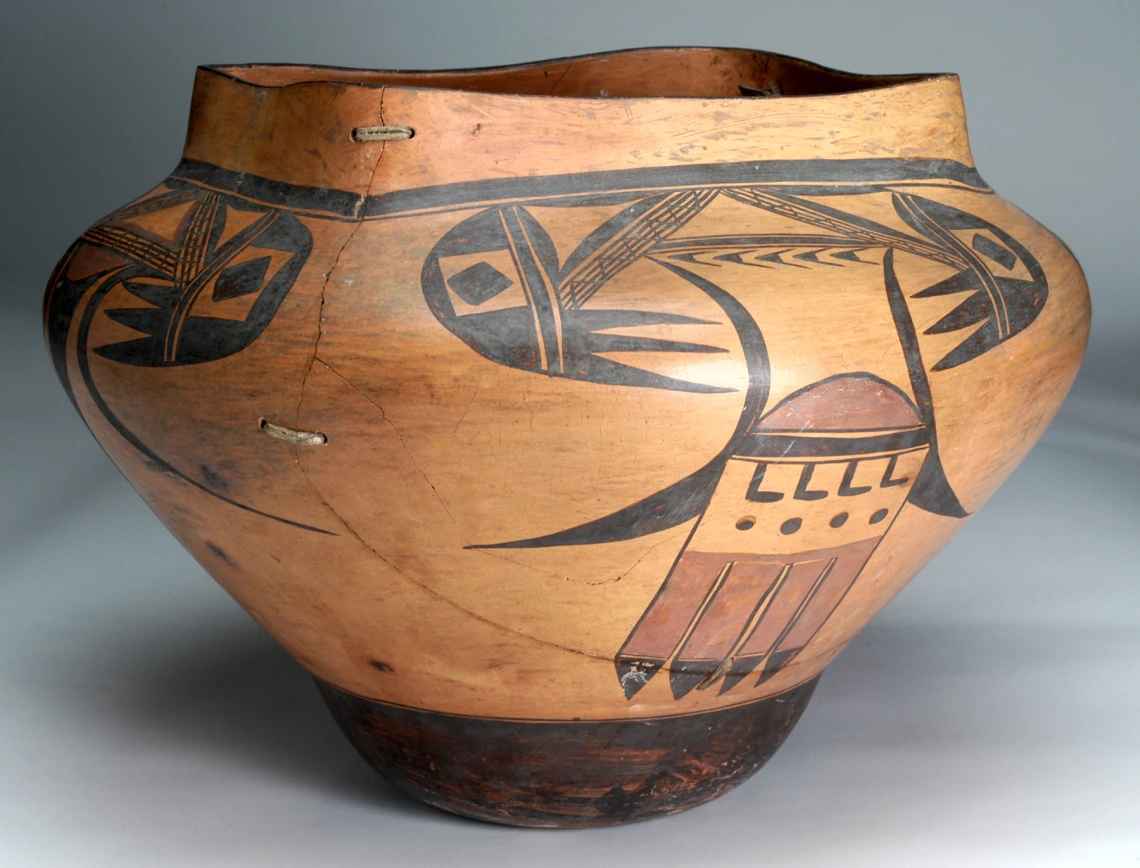
Large square-top polychrome olla, c. 1900–1920. Gift of the Gila Pueblo Foundation, 1951. Diameter 49 cm. (ASM #GP-52543).
"Polychrome jar, Hopi, Square top, made by Nampeyo." This rare jar, made of red-firing clay, came to ASM from the Gila Pueblo Foundation with no other documentation beyond the description above. It is the only vessel in the collection that bears a Harvey Company "Made by Nampeyo-Hopi" paper label. The jar appears to have broken post-firing and was repaired in a traditional fashion through drilling holes on either side of the break and binding the edges with sinew. The scale of this piece compares to that of Gila Pueblo jar GP-6215, and there is a good chance that Gila Pueblo Director Harold Gladwin purchased it at the same time, in September 1928. Nampeyo began to produce such immense high-shouldered vessels in the early 1900s, almost certainly with the assistance of members of her family. As her eyesight diminished, Nampeyo increasingly relied upon others to paint her jars.
No documentation accompanied this exquisitely painted jar that ASM received as part of the Gila Pueblo Collection. The crisp, well-executed rendering of a classic eagle-tail design on a low, wide-shouldered jar is typically Nampeyo. The design appears on jars shown in many photos of Nampeyo, including one by Adam Clark Vroman taken in 1901 (see next photo), and in an Edward S. Curtis portrait. The filled-in dots at the ends of the curl motifs on this jar led author Barbara Kramer to believe that this is not Nampeyo's painting, but that of her daughter Fannie, who favored this variation on the eagle-tail theme.
This one we call the migration design. And actually, what my mother says, is that it tells how many years [we] traveled, you know, from way back. Dextra Quotskuyva, 1998
This expertly painted wide-shouldered jar, which came to ASM with no documentation and as part of the Gila Pueblo Collection, is credibly attributable to Nampeyo. A daughter or clan relative was likely the painter. As with the other Nampeyo pots received from Gila Pueblo, it is likely that Gila Pueblo Director Harold Gladwin purchased this around 1926–1928. The elongated triangle motifs have been referred to as batwings as well as bird wings, and have appeared on pottery dating back at least 1,000 years. The hatched background is most often interpreted by potters as a migration design, the lines suggesting the paths taken by ancestral Hopi clans as they aggregated on the Hopi Mesas.
Regarding the migration design, author Barbara Kramer believed that Nampeyo was less likely to render it with the same level of detail that her two daughters later did. Kramer noted that where a bar of diagonal lines appeared in the wing design, as on this jar, older daughter Annie Healing would more likely have used dots. For this reason and due to the higher-than-average shoulder on the jar, Kramer leaned toward identifying granddaughter Rachel (1903–1985) as the painter. However, a similar jar in the collection of the Museum of Northern Arizona (E2630), with comparable diagonal lines and dating to 1935, is identified, based on a signature, as a Nampeyo/Fannie Nampeyo collaboration. The Elkus Collection in the California Academy of Sciences also contains a very similar migration-design jar by Nampeyo and Fannie. Given the strong similarities between this jar and the two that are clearly by Nampeyo and Fannie, a tentative attribution to this duo is warranted. A photo of Nampeyo holding a very similar jar, which appears in Wade and Cooke’s The Call of Beauty (2022:199) and likely dates to around 1920–1930, connects the artist to this style of migration-design jar. Exactly how is an open question, given the lack of proper context for the image.
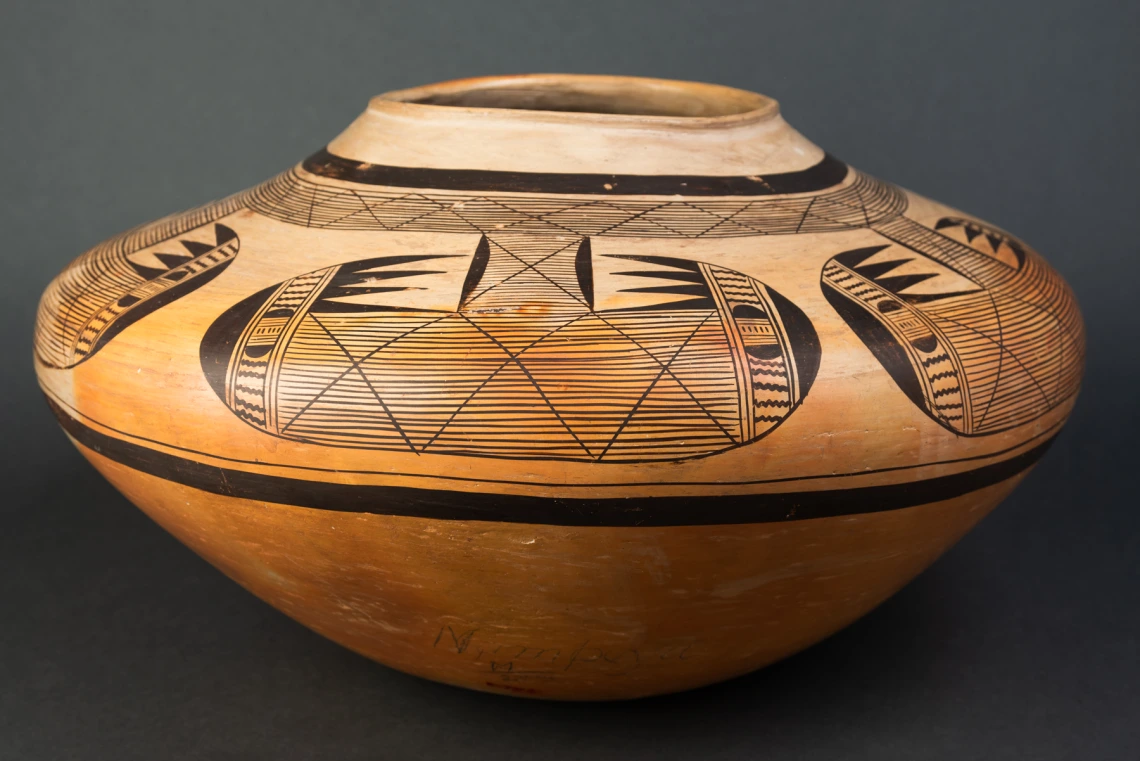
Large olla with bird-wing (also called batwing) design, c. 1920–1930(?). Gift of Jessica MacMaster (Mrs. Edward B.) Danson, 1941. Diameter 50.5 cm. (ASM #E-792).
Perhaps the most spectacular Nampeyo vessel at ASM, this massive jar was a gift from Jessica Danson, wife of anthropologist Edward B. Danson, who served as the director of the Museum of Northern Arizona from 1959 to 1975. Mrs. Danson purchased the jar at Babbitt's Trading Post in Flagstaff, Arizona, in April 1941; it had, according to Mrs. Danson, been there for many years. Nampeyo's name, along with “M 25.00,” is written in pencil on the side of the jar near the base. If we can believe that $25.00 was the selling price, it is a sign of wartime pricing that this jar appears to have sold for half of what a more modest jar (ASM #GP-6216) may have sold for 13 years earlier. Given the finely rendered migration design on this jar, if it is indeed a later work, the painting was almost certainly rendered by another Nampeyo family member. Researcher David Schramm believes that this olla may predate 1920 by several years.
A miniature version of this particular bird-wing design layout, signed “Fannie Nampeyo” (ASM #E-3654), may support the inference that she was the collaborator.
A relative likely wrote “Nampeyo” on the base of this bowl, whose very faded design exemplifies the decline in quality of Hopi pottery during the mid-1920s when tourist markets needed to be satisfied. Although anthropologist Ruth Bunzel, visiting Hopi in 1924 and 1925, found Nampeyo’s work to be "technically superior to that of any other Hopi potter," she deemed the overall quality of all Hopi wares, including Nampeyo’s, to be “abominable” (Bunzel 1972:68). While Nampeyo, along with her daughters, was still producing excellent work at this time, out of economic necessity it appears that she was making pots for both the casual tourist and more-discriminating patrons. It is also possible that the bowl may have been made by a completely different potter and the signature added as a favor from someone in the Nampeyo family.
Yeah, they didn’t have that much paint on it. It wasn’t enough paint. So that it just was not put on thickly enough. Mom taught me what do when you're testing your dye, she would have marks all over her arm, my mom. And she would say, “See, this is what happens. This pottery is just like us, because we are part of the clay and we are made out of the earth.” If you put the paint on there, on your clay, on your pottery, if you can't tell, do it on your arm. You put on there it will soak right in if your paint is right. If you know fix the paint just right for it to absorb into the clay. Then it's good, you won't have no problem, you know? So, you test it and either on your arm or on either another piece of clay, polished pottery and if it soaks, and you can it, she says, if you see if you’re applying it you’ll see that it’s soaking in right away. That means it won't come off, you know, when you fire. So the all these little tricks, you know, add up to a lot of your, uh, pottery, to get good at it. Dextra Quotskuyva
About Victor Stoner
Reverend Victor Stoner (1893–1957) was a Catholic priest who received an MA in archaeology from the University of Arizona. He had a particular interest in Spanish missions and Hopi people. He bequeathed his library and artifact collection to ASM.
Archaeologist Watson Smith, who excavated at the Hopi site of Awatovi, wrote in Stoner’s obituary (Smith 1957) that, on one of his trips to Hopi, Stoner had celebrated mass at the ruins of the San Bernardo Mission. This was the first time mass had been held there since 1680.
The collector of this jar, Nan Wood’s husband, Charles Morgan Wood (1879–1927), was a manufacturer and Western author from Dayton, Ohio, who retired to Tucson in 1923. He visited and photographed Native villages throughout the Southwest, including Hopi. Wood made a note in pencil on the base of this jar: “Bought from Nampeyo by CMW Aug. 1923.” He noted that it was made by Nampeyo and painted by her daughter, though he did not specify which one. The use of prickly pear motifs is not common. In the 1920s, swastikas found their way onto all forms of Indian arts, including pottery, textiles, jewelry, basketry, and beadwork. This practice was quickly curtailed in the next decades, when the symbol became associated with Nazism. Nampeyo’s daughter Annie (1884–1968) was known to incorporate swastikas into her work, so she may have decorated this vessel. However, because Wood photographed both Nampeyo and her daughter Fannie, likely in 1923, Fannie may well have been the painter of this jar.
Wood probably took this photograph of Fannie Nampeyo at the same time that he purchased the above jar. Because he noted that Nampeyo had made it with her daughter, it is reasonable to assume that Wood was referring to Fannie, who was 23 at the time.
The distinctive shape, design execution, and layout on this small version of two other eagle-tail jars suggest that it was made by Nampeyo. The jar—which was a bequest to ASM from Miss Leal Edmunds of North Dakota in 1968—once belonged to her father. It likely dates to around 1900–1920. By the early 1900s, Hopi potters were already making smaller pieces of pottery for sale.
Nampeyo’s biographer, Barbara Kramer (1996:153), suggested that the corrugation on the necks of some of her jars, such as this one, could have reflected her failing eyesight, which led her to experiment with textures. Nampeyo’s granddaughter Dextra Quotskuyva, recorded in an interview at ASM in 1998, felt that the corrugation was simply an artistic experimentation. The names "J.R. Willis" and "Nampuyo" both appear on the base, applied before the pot was fired. Willis was a photographer and artist who set up a studio in Gallup, New Mexico, in 1917 and then moved to Albuquerque in 1931. He photographed Nampeyo near her clan kiva in about 1918. It is likely that this jar was made and originally collected around this time. The donor did not indicate how the vessel came into her possession. Diameter 25 cm.
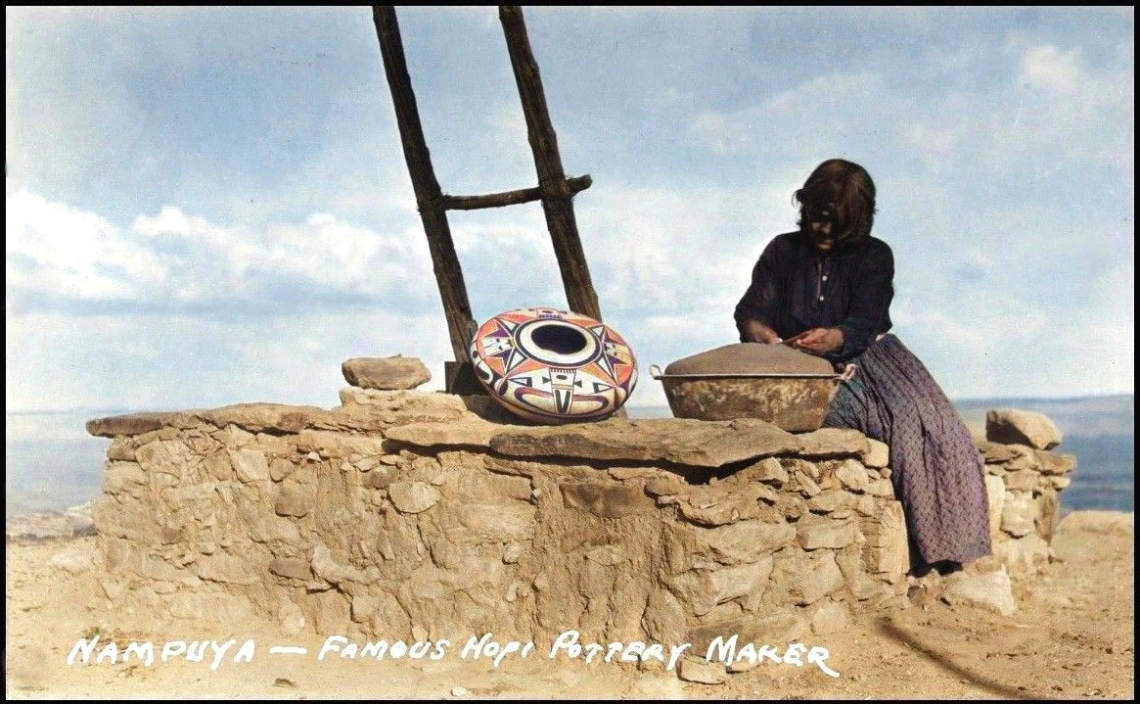
Postcard of Nampeyo shown using a metal pan to form the base of a large, wide-shouldered “flying saucer” jar, c. 1918. J. R. Willis, photographer. (See black-and-white photo under ASM #E-2273.)
In 1998 when Dextra Quotskuyva visited ASM, curator Diane Dittemore asked her if she still used these big basins. Dextra: Oh, yeah. They call them pukis. Yeah, I still use them. It's big pukis for bigger pots. I still have those.
This “flying saucer”–shaped jar bears Nampeyo’s name, which was painted on the base prior to firing. A gift of Miss Kathleen Carden in 1941, it was collected in 1934. Nampeyo’s biographer Barbara Kramer pointed to a less "Nampeyo" design style and the large painted red areas in suggesting that this vessel could have been painted by Lena Charlie of Hano. Researcher David Schramm leans toward Fannie as the painter. He observes that, to his knowledge, no examples of pottery formed by Nampeyo and painted by Lena Charlie have been identified.
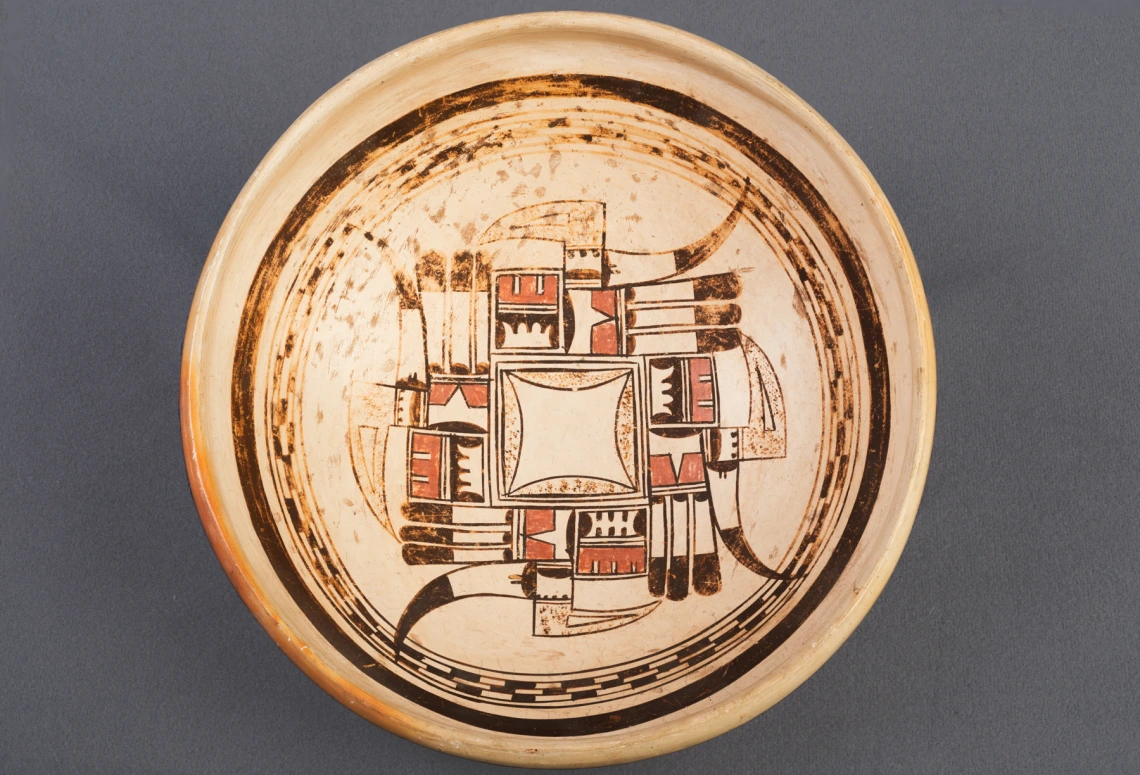
Polychrome bowl with composite feather design by Nampeyo, c. 1920. Gift of Edward Hamilton, 2022. Diameter 23.5 cm. (ASM #2022-507-1).
This Nampeyo bowl came to ASM in 2022 as a gift from Edward Hamilton, whose grandfather J. F. Breazeale collected it in the early 1920s. A photograph of the bowl appears in Breazeale’s 1923 book, The Pima and His Basket, which places Pima basketry in context among the arts of other Southwest Native people.
Upon the second mesa [sic; First Mesa] of Hopi land, near Palacca [Polacca], Arizona, lives another one of the wonderful women of America. Nampeyo is fifty-three years old and has two grown up daughters….A few months ago a young Hopi, Douglas Douma, of Palacca, wrote me, “Nampeyo still able to make them.” “Got two daughters.” “Make them better”....It was gratifying to know that Nampeyo is still able to “make them,” but as Douglas Douma married one of the daughters, due discount should be placed upon the statement that the daughters make them better. Nampeyo’s eyesight, of late years, has been very poor, but in spite of this she still sits out before her hut upon the second mesa [sic] and turns out as good work as she did in her younger days (Breazeale 1923:19).



















































